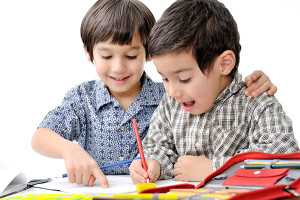
Ways to help your children develop empathy, kindness and a sense of responsibility toward others.
While rummaging through an old box, my daughter, Claire, came across the stuffed bear I’d had when I was her age, a deeply loved creature named Teddy. “How come Teddy has no fur?” she asked. “Why doesn’t she have eyes?” I explained that my cousin’s dog had chewed up Teddy when I was a kid. She was aghast.
Gravely, she kissed Teddy’s empty eye sockets. Somberly, she reported to her twin brother, Drew, what had happened. “We’ve got to fix her,” she said.
As it turns out, children have an inborn capacity for compassion. Small in stature themselves, they naturally identify with stuffed animals, other kids, pets, and underdogs. The tricky part is that their empathy must compete with other developmental forces, including limited impulse control—which makes them pull the cat’s tail—and their belief that their needs absolutely must come first—which makes it hard for them to let their cousin push the cool fire truck.
But with so much hatred and turmoil in the world today, it seems more important than ever to raise kids who can understand and be kind to other people. Tea
ching this doesn’t mean lectures or visits to soup kitchens. It’s part of day-to-day life: how you answer your child’s questions, how you solve conflict at the park, how you nudge his or her growing capacity to understand and think about other people. Temperament of course plays a role—some kids are naturally more tuned in to other people’s feelings and difficulties, while others are a bit oblivious. Either way, you have influence in fostering your child’s ability to empathize. Age by age, here’s how to do so in small, daily doses:
Promote sweetness
Teaching your child ways to treat things with care helps him develop the understanding that actions have consequences.
Show how to be gentle. Your child wants to be friendly but ends up grabbing the baby roughly? Demonstrate another way. “I say, ‘We use our hands to give love,'” says Kimberly Mazone of Dresden, Maine, mother of 4-year-old Sienna and 3-month-old Lucca. “‘You’re being a little bit rough. Let’s be gentle. Let’s show our love with our hands.'” You can actually take his hand and show him physically what a gentle touch is.
Speak softly. Your kindness will be a role model for how to treat others. When your child’s in pain, be warm and caring. “It’s all about the tone in your voice,” says Emily Mihalchik, a mom of 2-year-old Sam and director of the Johnnie Appleseed Preschool, in Lawrence, Kansas. If a child’s friend is crying, “I say, ‘Maybe a hug would be nice,'” says Mihalchik. Young toddlers don’t have a very consistent long-term memory, so you’ll have to repeat your lessons more times than you thought possible.
Reject rudeness. “I see fifteen-month-olds who do things like spit into their parents’ faces, and the parents laugh,” says Susan Jensen, a mom of two and director of Children’s Nook preschool, in North Charleston, South Carolina. This will not do. Compassion requires that your child respect others, including you. Gently but firmly, say “No, you may not spit!” In the same loving but no-nonsense manner, remove his little feet from the table and unlock his fist from your hair.
Say “I’m sorry.” If you’ve been short-tempered with your child, apologize to him. All parents make mistakes. It’s how you address them afterward that makes the difference. He’ll learn that everyone, even Mom, admits it when she’s wrong.
Enforce rules
Consistent limits help your toddler see that her behavior (and misbehavior!) affects others.
Provide structure. It might seem that if you want to raise a compassionate, caring child, you just have to be a compassionate, caring parent. But that’s not enough. Even the most nurturing, loving parenting requires firm limits on behavior, or you’ll get very self-centered children, says Janice Cohn, Ph.D., author of Raising Compassionate, Courageous Children in a Violent World. Make unacceptable behavior, like hitting, always unacceptable—even if it’s her birthday. If something is wrong it has to be wrong all the time.
Expect her to help. When their neighbors are away, Karen Semple’s four kids in Montana City, Montana, take care of the left-behind cats, dogs, and horses. Everyone’s included in helping, and when the youngest was 2, she scooped cat food out of a bag. Rain, snow, and cold weather don’t stop them. For Semple, it’s all about teaching the Golden Rule. “You need to love your neighbor as yourself, even if you don’t particularly feel like it,” she says.
Use manners to connect. With the exciting (and noisy!) arrival of the garbage truck, talk about how we’re all connected: The farmer grows the food, we throw out the peels or waste, and the trash collector picks it up. If your child’s out watching the trash collector, she can say “thank you.” Good manners, which keep us coexisting harmoniously, are one way to show compassion. As much as you can with a squirmy toddler, make good manners part of her daily routine.
“Habits like this can help form character,” says the Reverend Dr. Julia Gatta, an Episcopal priest and associate professor of pastoral theology at the University of the South in Sewanee, Tennessee. “There’s another person at the other end of the relationship who has feelings and deserves respect.”
Guide friendship
Stay tuned in during playtime so you can help your child figure out how to be a friend.
Outlaw name-calling. Compassion starts with what’s acceptable and what’s not. “A little guy called someone a ‘poo-poo head,'” says Jensen. “Immediately, he had to go to time-out or come up to see me. I told him, ‘I know you know that word is unacceptable.'” Explain to her—often—that being kind to others is the rule. You can tell her when she gets into a tiff, “You don’t have to like that person, but everyone has to be nice.”
Give consequences. If the be-nice rule is broken, stick with simple, concrete consequences such as a brief time-out or losing a special toy for a day. A 3-year-old’s abstract thinking is weak, so she’s too young to understand that being nice is morally the right thing to do; your efforts, therefore, should be directed at helping her resist impulses so she won’t get in trouble.
Label kindness. When you catch your child offering a shovel to a friend in the sandbox, label her actions by saying “What a good friend you are,” or “You’re very thoughtful.” Over time, she’ll understand that being a helpful friend, sister, neighbor, and human being is something you value.
Be considerate yourself. While it’s tempting to hand out birthday-party invitations at the park instead of going to the trouble of mailing them, explain to your child that kids who see other children getting invitations but don’t receive one themselves may feel hurt. And all through the year, get her in the habit of sending cards to friends and relatives who could use a kind word: thank-you notes, sympathy cards, get-well wishes. For a child not yet up to writing a message, even a drawing is great.
Don’t trash talk. Kids, as we know, are always listening. How we talk on a daily basis about our own siblings, parents, and relatives tells them a lot. If children hear us saying something really negative about Grandma, they learn that it’s okay to talk that way, says Suzanne Coyle, Ph.D., a mom and director of the Marriage and Family Therapy Program at Christian Theological Seminary in Indianapolis. So keep meanness in check: “Show them you have a spirit of kindness and generosity.”
Encourage helping
With their increasing awareness and independence, preschoolers are ready to participate, if you show them how.
Give pennies. Kids want to feel they can make a difference, so bring charity down to their level. “Every week the children bring in pennies and count them,” says Nancy Manewith, director of the Board of Jewish Education Early Childhood Centers of Metropolitan Chicago. “It’s just part of our pre-math program.” Then the pennies go to charity or to buy mittens and scarves for poor children, which opens the door to conversations about war and poverty.
When talking to your own child about such things, be honest, but don’t feel you have to include every scary detail. Keep explanations simple, and ask simple questions, like “How can we help them?” If his al-lowance is five dimes, ask him how many dimes he’d like to set aside to give to a food bank or drop in a collection jar. Giving him the choice will make him more excited about the idea.
Assign chores. The habit of helping others starts with chores at home. Children love to feel capable, so assign a manageable task like setting the table or feeding the cat. Make a schedule and put it on the fridge so your child can keep track of what he needs to do. When her kids ask why they have to do chores, Anna Notation-Rhoades of Sewanee, Tennessee, a mom of five, tells them “we’re all part of the family, so by helping the family we’re helping ourselves.”
Use stories. Reading books together can be a natural way to help your child start to understand that children aren’t all the same. Books like Faith the Cow, by Susan Bame Hoover, about how the gift of a cow can change the life of a poor family, or Houses and Homes, by Ann Morris, which has photos of houses around the world, can show that kids in other countries want the same things: to feel safe, to be liked, to learn things, to have fun, and to be with their families.
Point out heroes. The siren of a fire truck, not to mention a newspaper photograph of a bomb attack, can make a 4-year-old worry. Shield him from disturbing images as much as possible, but when he hears or sees something frightening, focus the conversation on the firefighters, rescue workers, doctors, or volunteers who are there to help us.
Build on their smarts
Your child’s made cognitive and emotional leaps—help him understand others’ feelings.
Explore feelings. With an increasing vocabulary, a 6-year-old is able to communicate more about emotions. Talking about book characters is a good way to help. “We’d read Snow White and I’d ask, ‘Why do you think the witch was jealous of Snow White?'” says Rev. Gatta, who’s also a mom of a 12-year-old. “Later, maybe in the car, we’d talk about characters’ motives and feelings.”
Monitor media. If the characters on television are hitting each other or calling each other names, shut off the TV or, at least, talk about what’s going on. Children don’t just watch TV, they internalize it, and they don’t get irony, so be careful of what they’re memorizing.
Expect more. When it comes to your child’s responsibility to be caring and compassionate, set your standards high. Don’t let teasing or bullying go unaddressed. At 7 and 8, kids are starting to be able to see the world from another person’s perspective. In a complicated and troubled world, it’s easy to feel that nothing we do will make a difference. This can lead to compassion burnout—for us and for our kids. The key is to start small.
As for my battered Teddy, it was a very small problem in search of a solution. So we repaired her. Claire chose blue felt for her eyes and pink for her nose. She cut out the shapes, which made them interesting to behold. Teddy’s not her old furry self, but she’s much improved. Now, years later, every time Claire hugs my old bear, she knows she made a difference.






















